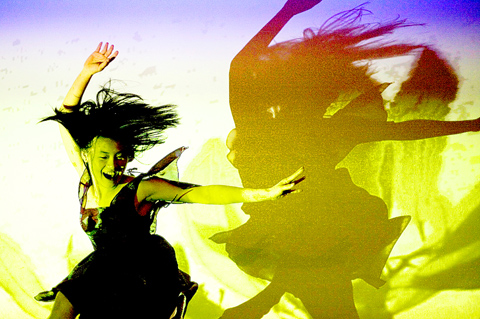For Taiwanese choreographer Ku Ming-shen (古名伸), dance, like life, is all about making connections, making contact. Who you meet in life and when you meet them has an influence on who you are, what you are and who you will be.
She is celebrating those connections this weekend as well as the 15th anniversary of her dance troupe with performances at Taipei’s Novel Hall, set around the numbers three, six and 10: three “generations” of choreographers, six works and 10 dancers.
“The group is composed of three sets of choreographers. I’m the oldest one. Su An-li (蘇安莉) and Mei-li [Li Mei-kuang (黎美光)] have been with me for more than 10 years. Wang Pei-chun (王珮君) and Chu Sing-leung (朱星朗) have been with me for about six years,” Ku said.

PHOTO: COURTESY OF KU & DANCERS
Ku is probably the best-known proponent of Contact Improvisation (CI) dance in Taiwan. CI began as a dance form in the early 1970s in the US as an exploration of the physics of motion and contact between bodies. Dancers incorporated moves from other disciplines, such as gymnastics and martial arts, adding rolls and falls to dance lifts and jumps.
The emphasis is on sharing balance from the point of contact — whether that point is another body or an object such as a chair or a wall — and following impulses. Most of the early pieces revolved around duets or solos, but over the years large jams have become a common feature of CI workshops or festivals. It may look freeform and loose, but practitioners must be constantly aware of themselves and their partners, both to further the piece and to prevent injuries.
Ku learned about Contact Improvisation after quitting her job teaching dance at the Chinese Cultural University and going to New York to study on a grant in 1991 and 1992. She has spoken often of the immediate connection she felt to CI and she founded her company in 1993 to promote improvisation.

PHOTO: COURTESY OF KU & DANCERS
“The company has always had two parallel directions — improvising and set pieces,” Ku said in a telephone interview on Tuesday. “But I thought it important for this anniversary to choose a fancy space for a celebration. But once we decided on a venue, it did affect the thinking for all the pieces.”
“I didn’t tell them [the other choreographers] what to do. I told them to do their own thing. We are aesthetically different, though of course there is some melding,” she said.
“An-li worked with a musician on her piece (Letter From Attica). It has got its own flavor; it’s cutting-edge. She made it for her grandmother who died a few years ago. The past and present are joined and yet are missing each other in this space.” Ku said.

PHOTO: COURTESY OF KU & DANCERS
“For the past couple of years Pej-chun and Chris [Sing-leung] have used multimedia and improvisation. The use of multimedia [in performances] is a global trend. It is an amazing tool. You can create something no one imagined before. I started in 2000 to use it because of some people I met, some people who were really good in this area. Chris has an engineering background, he is our computer person, so when he does his own work he will grab this [tool],” Ku said.
Technology has been a big boon to the creative process in many fields. Ku said real time software has been especially useful, because everything happens in the present time. As a choreographer, Ku said the idea of being able to use time creates an extra dimension for her work.
“My piece [Rendezvous] uses opera. It’s much brighter, more like a statement for production. But just last week I realized it is based on the same theme [as the other pieces] — how people meet each other, how people happen or connect. The people are competitors but it’s a duet,” she said.

PHOTO: COURTESY OF KU & DANCERS
Ku said meeting people is not just the theme of the show, but of her company and her life. “Even though we are Ku & Dancers, the dancers are the key. Every new person who joins the company brings something different. From there I see who we meet, where we go. Dance companies influence each other; it’s all about connections,” she said.

PHOTO: COURTESY OF KU & DANCERS

On April 26, The Lancet published a letter from two doctors at Taichung-based China Medical University Hospital (CMUH) warning that “Taiwan’s Health Care System is on the Brink of Collapse.” The authors said that “Years of policy inaction and mismanagement of resources have led to the National Health Insurance system operating under unsustainable conditions.” The pushback was immediate. Errors in the paper were quickly identified and publicized, to discredit the authors (the hospital apologized). CNA reported that CMUH said the letter described Taiwan in 2021 as having 62 nurses per 10,000 people, when the correct number was 78 nurses per 10,000

As we live longer, our risk of cognitive impairment is increasing. How can we delay the onset of symptoms? Do we have to give up every indulgence or can small changes make a difference? We asked neurologists for tips on how to keep our brains healthy for life. TAKE CARE OF YOUR HEALTH “All of the sensible things that apply to bodily health apply to brain health,” says Suzanne O’Sullivan, a consultant in neurology at the National Hospital for Neurology and Neurosurgery in London, and the author of The Age of Diagnosis. “When you’re 20, you can get away with absolute

May 5 to May 11 What started out as friction between Taiwanese students at Taichung First High School and a Japanese head cook escalated dramatically over the first two weeks of May 1927. It began on April 30 when the cook’s wife knew that lotus starch used in that night’s dinner had rat feces in it, but failed to inform staff until the meal was already prepared. The students believed that her silence was intentional, and filed a complaint. The school’s Japanese administrators sided with the cook’s family, dismissing the students as troublemakers and clamping down on their freedoms — with

As Donald Trump’s executive order in March led to the shuttering of Voice of America (VOA) — the global broadcaster whose roots date back to the fight against Nazi propaganda — he quickly attracted support from figures not used to aligning themselves with any US administration. Trump had ordered the US Agency for Global Media, the federal agency that funds VOA and other groups promoting independent journalism overseas, to be “eliminated to the maximum extent consistent with applicable law.” The decision suddenly halted programming in 49 languages to more than 425 million people. In Moscow, Margarita Simonyan, the hardline editor-in-chief of the